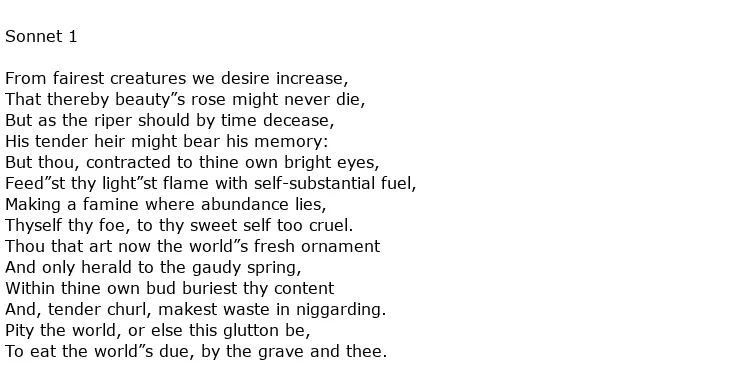William Shakespeare (c. 1564–1616) stands as arguably the most celebrated figure in the English language. While his immense fame primarily stems from his 37 plays, it is a significant oversight to neglect his equally profound contributions to poetry. Shakespeare authored over 150 poems, showcasing a mastery of language and form that extends far beyond the stage. Delving into a poem from Shakespeare, whether a concise sonnet or a lengthy narrative, offers unique insights into his genius and the evolution of poetic expression.
Contents
Shakespeare’s Sonnets: A Masterclass in Form
The majority of Shakespeare’s poetic output consists of his famous 154 sonnets. These fourteen-line poems adhere to a specific structure that has come to be known as the Shakespearean or English sonnet form. This form typically follows an A B A B C D C D E F E F G G rhyme scheme, concluding with a rhyming couplet.
In his very first sonnet, Shakespeare immediately demonstrates his command of this structure while contemplating profound themes, in this case, the imperative of procreation to preserve beauty against the ravages of time. Here is the beginning of Sonnet 1:
From fairest creatures we desire increase,
That thereby beauty’s rose might never die,
But as the riper should by time decease,
His tender heir might bear his memory:
But thou, contracted to thine own bright eyes,
Feed’st thy light’s flame with self-substantial fuel,
Making a famine where abundance lies,
Thy self thy foe, to thy sweet self too cruel.
Analyzing a poem from Shakespeare like Sonnet 1 reveals not just his structural adherence but also his remarkable ability to weave complex thought and vivid imagery within strict formal constraints. The flow of ideas across the quatrains, culminating in the final couplet (though only the first eight lines are shown above), is a hallmark of his sonnet craft. For those interested in exploring more, many poems of shakespeare are readily available for study.
Themes and Historical Context
While later poets explored a vast array of subjects, a notable portion of Shakespeare’s poetry, particularly his sonnets, focuses intensely on themes of love, beauty, time, and mortality. Understanding the historical context is crucial. During the Elizabethan era, professional writers often relied on patronage. Poetry, especially love sonnets, was a form favored by nobles and upper society, making it a viable avenue for a poet to earn a living or gain favor. This economic reality likely influenced the thematic focus of much of his work. However, to reduce them purely to commercial endeavors would be unfair; Shakespeare infused these common themes with unparalleled psychological depth and linguistic artistry. You can find many shakespeare poems about love that exemplify this.
Beyond the Sonnets: Shakespeare’s Narrative Poems
Less known than his sonnets are Shakespeare’s two major narrative poems: Venus and Adonis (published 1593) and The Rape of Lucrece (published 1594). These longer works differ significantly from the sonnets in both form and scope, presenting detailed stories rather than condensed meditations. Written relatively early in his career, they might be seen as experiments in epic or mythological storytelling.
Venus and Adonis
The earlier narrative, Venus and Adonis, is an Ovidian tale depicting the unrequited love of the goddess Venus for the beautiful youth Adonis. Commissioned for the Earl of Southampton, Shakespeare employs a six-line stanza form (sestina) and rich, sensuous language to tell the story. The poem delves into themes of passion, desire, and the conflict between love and chastity. Shakespeare’s deep engagement with classical mythology, evident in this work, links him to the literary traditions that inspired many Renaissance poets.
The Rape of Lucrece
The Rape of Lucrece is a darker, more tragic narrative, written in rhyme-royal stanzas (seven-line stanzas). It recounts the story of the virtuous Roman noblewoman Lucretia and the devastating consequences of her rape by Tarquin. This poem from Shakespeare explores themes of honor, violation, tyranny, and vengeance. Readers familiar with his plays will recognize thematic echoes, particularly with tragedies like Hamlet or Macbeth, suggesting how his work in narrative poetry may have informed his dramatic writing. Exploring shakespeare small poems alongside these larger narratives offers a fuller picture of his versatility.
The Enduring Influence of Shakespeare’s Poetry
For aspiring poets and dedicated readers alike, studying Shakespeare’s poetry offers invaluable lessons in craft, structure, and the profound exploration of the human condition. His sonnets provide a masterclass in compressing complex emotion and thought into a rigid form, while his narrative poems showcase his ability to sustain intricate storytelling through verse. The influence of Shakespeare’s poetic works on subsequent generations of poets is immeasurable; many modern poets have studied, emulated, and responded to his innovations. To truly appreciate the foundations of English poetry, one must engage with the words written by “The Bard.” His ability to connect technical brilliance with emotional resonance ensures that a william shakespeare small poem or a grand narrative still speaks powerfully to readers today, continuing to establish the artistic value of poetry.


